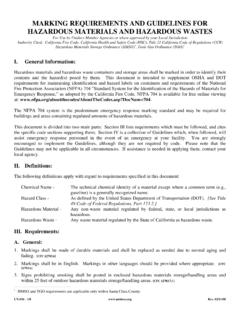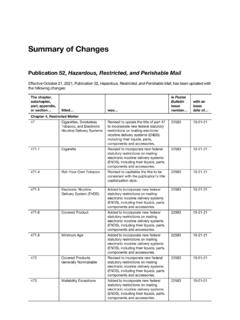Transcription of Latest Revision: ANSI/ASME A13.1-2015 - Seton
1 Several laws and regulations exist regarding Pipe Markers and Valve Tags. Most prominent of them are the Occupational Safety and Health Act (OSHA Act of 1970) and the Federal Mine Safety and Health Act of 1977. Click here to shop for pipe markers and valve is the pipe identification standard most commonly used in the United States. The standard specifies the primary and secondary means of identifying pipe contents, as well as the size, color and placement of the identification PIPE IDENTIFICATIONThe text legend (name of pipe content) and directional arrow remain the primary means of identifying pipe contents. Attaching arrows at one or both ends of the marker indicates flow direction. See the ANSI/ASME size chart and installation guide in the following sections for more PIPE IDENTIFICATIONA secondary means of pipe marker identification is the color code of the marker.
2 The terminology of inherently hazardous or nonhazardous has been removed from the standard, effective since 2007. The combination of Yellow/Black is now assigned to flammable fluids and oxidizing fluids while Green/White pipe markers identify potable, cooling, boiler feed and other water-related substances. These updates mean that legends such as hot water, cold water and steam will now use the color code of Green/White. Seton still offers many Yellow/Black pipe markers for these contents from many our top-selling brands as significant color changes in 2007 included the addition of Brown/White for combustible fluids and Orange/Black for toxic or corrosive fluids. The fact that the standard has identified specific colors for flammable liquids, combustible fluids and toxic or corrosive fluids means Safety Data Sheets should be consulted before selecting a color.
3 Further, if the pipe being labeled contains multiple hazards -- like flammable and toxic -- determining which poses the greater hazardous risk is vital and should dictate the way in which your pipe is marked. If chilled or heating systems contain toxic treatments, for example, the color combination should be Orange/Black. The 2007 standard also identified four additional defined by user color combinations for additional customization options on non-standard markers. Those exact colors are the recommended safety colors contained in the ANSI updates to ANSI/ASME added oxidizing fluids to the definitions for Yellow/Black, but did not add any new colors to the MARKER GUIDELINESL atest Revision: ANSI/ASME your Safety Expert at or visit today!Call your Safety Expert at or visit today!PIPE MARKERS OVER THE YEARSW hite on RedBlack on OrangeBlack on YellowWhite on BrownWhite on GreenWhite on BlueWhite on PurpleWhite on GreyWhite on BlackBlack on WhiteFire quenching fluidsToxic & corrosive fluidsFlammable & oxidizing fluidsCombustible fluidsPotable, cooling, boiler feed, & other waterCompressed AirDefined by userFLUID SERVICECOLOR SCHEMEANSI/ASME GUIDELINESCURRENT Flammable or Explosive Chemically Active or Toxic Extreme Temperature/Pressure RadioactiveSUB CLASSIFICATIONCOLOR SCHEMEL iquid or liquid admixtureGas or gaseous admixtureWater, loam, CO2, Halon, hazardous MaterialsInherently Low Hazard MaterialsFire Quenching MaterialsCLASSIFICATIONW hite on RedBlack on YellowWhite on GreenWhite on BlueANSI/ASME GUIDELINESOUTDATEDTHE OFFICIAL ANSI/ASME COLOR guidelines STATES.
4 Color should be used to identify the characteristic hazards of the contents. Color should be displayed on, or contiguous to, the piping by any physical means, but its use shall be in combination with the legend. Call your Safety Expert at or visit today!PIPE MARKER GUIDELINESSETON PIPE MARKING SYSTEMS MEET THE ANSI/ASME STANDARDA ccording to the standard, pipe markers should be positioned so that they are readily visible to plant personnel from the point of normal approach. Seton pipe markers instantly tell you all you need to know about pipe contents, direction of flow and whether they re hazardous or TO PROPERLY LABEL PIPES1. Obtain a legend list of all pipe contents in your Collect the following data on your piping systems (this may require tracing lines to determine quantities and sizes): Pipe contents Outside diameter of pipe (including insulation) Quantity of markers needed per ASME/ANSI or other standards Pressure Temperature To/from information Location of specific legends by area (for aid in installation)**Note: You may be able to use blueprints or P&IDs if they are current instead of walking down all of your lines.
5 Seton also offers Take-Off Services to help you determine your pipe marking Select color of THE RIGHT PIPE MARKER1. SIZES eton pipe marking systems meet ANSI/ASME size standard also makes recommendations as to the size of letter height and length of color field for various pipe diameters. These recommendations are shown in the table below. Seton markers, when used properly with arrows and banding tape or arrow tape, meet or exceed the - 1-1/4 (19mm - 32 mm 8 (203mm) 1/2 (13mm)1-1/2 - 2 (38mm - 51mm) 8 (203mm) 3/4 (19mm)2-1/2 - 6 (64mm - 152mm) 12 (305mm) 1-1/4 (32mm)8 - 10 (204mm - 254mm) 24 (610mm) 2-1/2 (64mm)over 10 (over 254mm) 32 (813mm) 3-1/2 (89mm)Note: For pipes less than 3/4 in diameter, a permanently legible tag is recommendedFITS PIPE OUTER DIAMETERLENGTH OF COLOR FIELDLETTER HEIGHTCall your Safety Expert at or visit today!)
6 CHOOSING THE RIGHT PIPE MARKER2. COLORS eton pipe marking systems meet ANSI/ASME color pipes are dangerous to both life and property. Numerous injuries have occurred due to the ignorance of pipe contents, particularly when outside agencies are involved during emergency of materials (from the official ANSI/ASME guidelines ):Fire Quenching: This classification includes water, foam, and CO2 used in sprinkler systems and fire fighting piping and Corrosive: This classification includes fluids that are corrosive or toxic, or will produce corrosive or toxic substances when : This classification includes fluids, which, under ambient or expected operating conditions, are a vapor or produce vapors that can be ignited and continue to burn in : This classification includes fluids that can burn, but are not (new addition for 2015 standards).
7 Oxidizing fluid is any gas or liquid that may, generally by providing oxygen, cause or contribute to the combustion of other material more than air , cooling, boiler feed and other water: Clean water usable fordrinking, bathing, washing, can be oxidized and is not harmful ortoxic in any Air: Air kept under a pressure that is greater than atmospheric pressure. Used for domestic and industrial on RedBlack on OrangeBlack on YellowWhite on BrownWhite on GreenWhite on BlueWhite on PurpleWhite on GreyWhite on BlackBlack on WhiteFire quenching fluidsToxic & corrosive fluidsFlammable & oxidizing fluidsCombustible fluidsPotable, cooling, boiler feed, & other waterCompressed AirDefined by userFLUID SERVICECOLOR SCHEME3. WORDINGOver 150 stock legends available!Still can t find the wording you need? No problem: We can customize markers to your exact your Safety Expert at or visit today!
8 CHOOSING THE RIGHT PIPE MARKER4. GHS PICTOGRAMSC ommunicate hazard information with your Pipe Markers through GHS 2015 incorporated GHS pictograms into the 2015 revision, recommending their use as part of the legend. A corresponding piping label may be provided with pipes connected to containers labeled in accordance with GHS requirements. The corresponding label should contain at least the product name or identifier, the pictogram, the signal word and the physical, health and environmental hazard statement(s).*The applicable GHS pictogram as illustrated may be included as part of the legend. GHS pictograms available for select pipe markers only. Health Hazard Carcinogen Mutagenicity Reproductive Toxicity Respitory Sensitizer Target Organ Toxicity Aspiration ToxicityFlame Flammables Pyrophonics Self-Heating Emits Flammable Gas Self-Reactives Organic PeroxidesExclamation Mark Irritant (skin and eye) Skin Sensitizer Acute Toxicity (harmful) Narcotic Effects Respiratory Tract Irritant hazardous to Ozone Layer (Non-Mandatory)Gas Cylinder Gases Under PressureCorrosion Skin Corrosion / Burns Eye Damage Corrosive to MetalsExploding Bomb Explosives Self-Reactives Organic PeroxidesFlame Over Circle OxidizersEnvironment Skull(Non-Mandatory) Eye DamageSkull & Crossbones Acute Toxicity(fatal or toxic)For more than 60 years, Seton has served as the most trusted source of pipe markers for architects, engineers, contractors and specifiers.
9 In fact, we ve been written into more project specs than any other company! Our OSHA-authorized contractor specialists are available to help with all your project needs. Between their hands-on experience in the field and unparalleled expertise, they will help you ensure your jobsites are safe, compliant and on budget. We re proud to carry a wide variety of pipe marking products which are fully compliant with current ANSI standards as well as customizable to meet the specific needs of your projects. Seton is the industry leader in pipe marking: See why for more information on the ANSI/ASME Standard, please visit the following the American National Standards Institute online at: (1)






